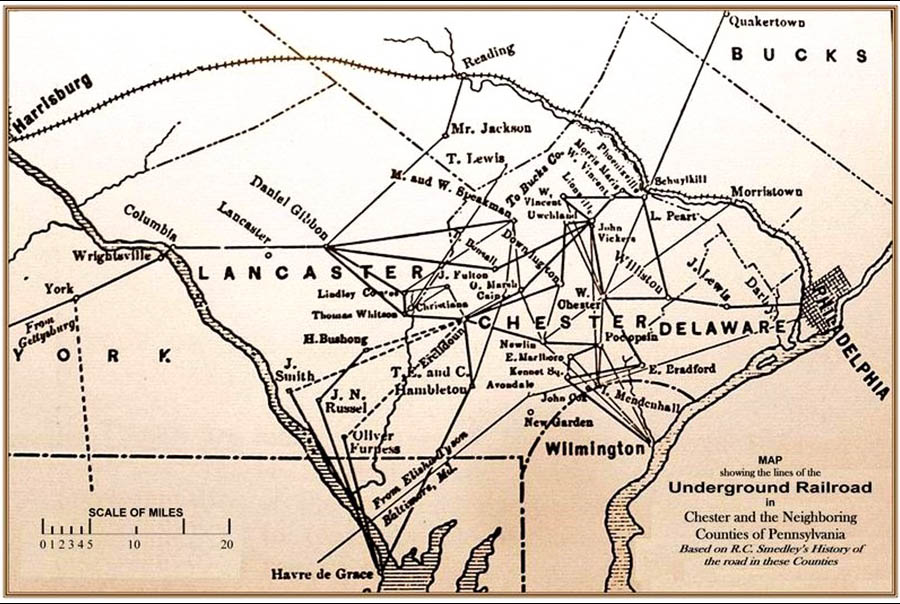The Underground Railroad
The Underground Railroad
 The Underground Railroad was a physical, social, and political movement of self-liberation by people of African descent, often assisted by free people of color and white people. It was a movement about movement — people of color seeking their freedom by moving on their own or being transported by a variety of means by others who were sympathetic to them.
The Underground Railroad was a physical, social, and political movement of self-liberation by people of African descent, often assisted by free people of color and white people. It was a movement about movement — people of color seeking their freedom by moving on their own or being transported by a variety of means by others who were sympathetic to them.
According to author and historian Fergus Bordewich (Bound for Canaan and Congress at War), the Underground Railroad is represented by many firsts:
- First mass civil disobedience since the American Revolution;
- First civil rights movement in the United States;
- First large-scale opportunity for African Americans to engage in politics and organizational movement; and
- First “seedbed” of American feminism.
The Underground Railroad is shrouded in many myths, but it was not about…
- Railroad trains running long distances through tunnels underground from the southern states to the free states of the north*
- Directional symbols sewn into quilts that enslaved people were supposed to follow
*Although it should be noted that in southeastern Pennsylvania, one of the earliest railroad lines in America was used to secretly transport formerly enslaved people from York and Lancaster Counties to Philadelphia and points north.
Time Period of Underground Railroad Activity in Pennsylvania and the Southeast
In Pennsylvania, the years of the Underground Railroad formation, organization, growth, and eventual decline occurred between 1780 and the early 1860s, when the Civil War began in 1861, and followed by the Emancipation Proclamation of 1863.
The earliest stirrings in Pennsylvania can be traced to the end of the American Revolution and formation of the US Constitution in the 1780s. The Gradual Abolition Act enacted in March 1780 also set in motion the gradual dismantling of the institution of slavery in Pennsylvania, the first such act by a state government in the western hemisphere. (Want to know more about the Gradual Abolition Act? Check out our digital exhibition.)
Location of Underground Railroad Activity in Southeastern Pennsylvania
The counties of southeastern Pennsylvania strung along the Mason-Dixon Line (the border between Pennsylvania and Maryland) have the highest recorded involvement in Underground Railroad activity. The Mason-Dixon Line divided the free states of the north from the states that permitted slavery along the Atlantic seaboard.
Although there are probably hundreds of sites with compelling human interest stories associated with the Underground Railroad in Lancaster County and the surround counties, only a few have been well document and recognized by the National Park Service and its Network to Freedom program. The following are National Park Service-designated sites and resources:
In Lancaster County
- The ruins of the 1832 Columbia-Wrightsville Bridge and the nearby ruins of the c. 1830 Pennsylvania Canal (Columbia)
- The Columbia National Bank Museum (Columbia)
- The Old Lancaster County Jail (now the Fulton Theatre, Lancaster)
- Site of the Philadelphia & Columbia Railroad and the Amtrak Keystone Corridor from Lancaster to Philadelphia
- Shreiner-Concord Cemetery
- Zercher’s Hotel and the Christiana Underground Railroad Visitors Center (Borough of Christiana)
- The live performance program, Living the Experience, presented by the Bethel African Methodist Episcopal Church (Lancaster)
- LancasterHistory Research Center (Lancaster)
- The Thaddeus Stevens & Lydia Hamilton Smith Center for History and Democracy (Lancaster)
In York County
- The William C. Goodridge House (City of York)
- The Willis House (City of York)
For more about the National Park Service’s Network to Freedom program, visit their website at https://www.nps.gov/orgs/1205/index.htm.
Movement on the National Level
 Nationally, historical records show that increased resistance to slavery and the rise of abolition movements and Underground Railroad activity began to occur the last quarter of the 18th century. In particular, it occurred in the wake of the American Revolution and from 1800-1860, with peak resistance in the 1830s to late 1850s. This peak coincides with the formation and development as the earliest railroads in America, including the Philadelphia & Columbia Railroad.
Nationally, historical records show that increased resistance to slavery and the rise of abolition movements and Underground Railroad activity began to occur the last quarter of the 18th century. In particular, it occurred in the wake of the American Revolution and from 1800-1860, with peak resistance in the 1830s to late 1850s. This peak coincides with the formation and development as the earliest railroads in America, including the Philadelphia & Columbia Railroad.
Persons Involved
While research continues to uncover names, people supporting the Underground Railroad were from various backgrounds and beliefs. Similarities, however, did occur, such as many being advocates for free public education, temperance leadership, certain members of political parties under the banners of Anti-Masons, Whigs, and radical Republicans, and some religious leaders, notably more progressive Quakers, African Methodist Episcopalians, Methodists, and Anabaptists (Mennonites). Others were business owners and operators engaged in iron making, lumber, the railroad, publishing, journalism, and legal counsels.
Learn More
Check out our other resources on African American and Underground Railroad history.
African American Heritage Markers
Gradual Abolition in Pennsylvania Digital Exhibit
Timeline: The Underground Railroad in Lancaster County
We also have various pre-recorded lectures available on our YouTube channel.
LancasterHistory also offers group and private tours that focus upon the origins of the Underground Railroad in Lancaster County. To review those options, please visit our Group Tours page.
